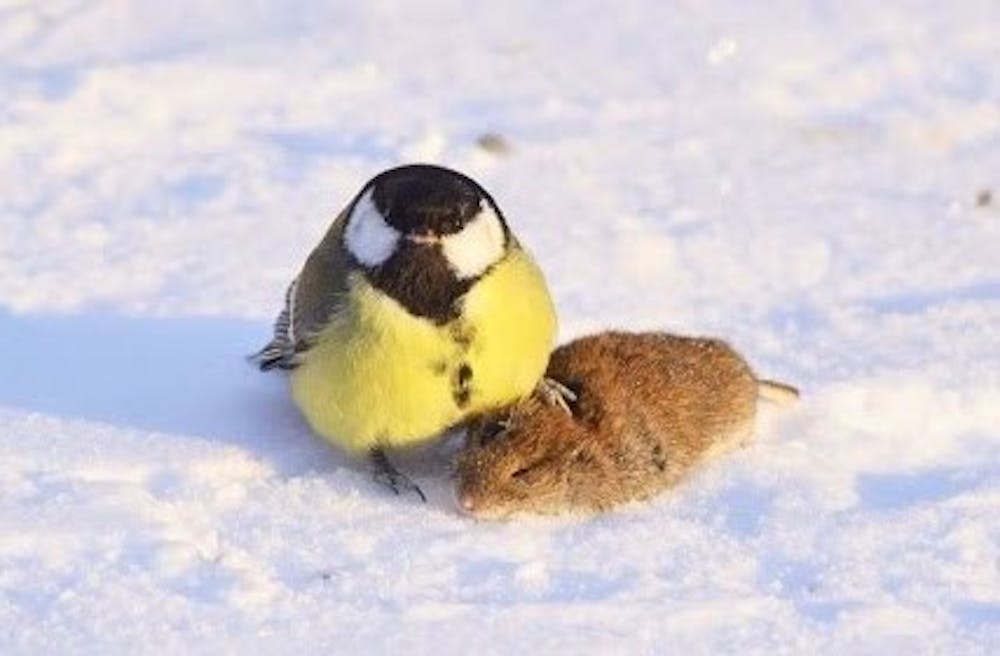Editor's Note: This piece was originally published online in the UNM BioBlog on September 4th, 2018, written by Jenna McCullough. This is part of our project to help connect the Daily Lobo audience to more members of our community.
When you think of a songbird, like a finch or a sparrow, what kind of food does it eat? For many people, the first thing that comes to mind is bird seed — it fills feeders and the shelves of our local bird-watching stores. But songbirds are more diverse than finches at your neighborhood feeder and they eat more than just idyllic bird seed.
“Songbirds” specifically refers to oscine passerines, which at its core is a perching bird with complex vocal organs. They’re found all over the world and have dynamic diets. Brown Creepers and nuthatches probe tree trunks for insects, Australian honeyeaters use their brush-tipped tongues to eat flower nectar, and Cedar Waxwings will gorge themselves on fermenting berries (sometimes to the point that they are intoxicated).
Shrikes, one of the few groups of predatory songbirds, will impale their prey items (i.e., insects, snakes, small rodents, birds) on thorns or barbed wire for a tasty meal later. Songbirds are the most species-rich group of birds on Earth and take advantage of diverse resources, and we ornithologists are learning more and more about their diets each day.
A few months ago, I saw a photo of a European songbird, the great tit (Parus major), proudly standing over a dead vole, surrounded by snow on twitter. I was astonished to learn that it had killed this vole — I had thought that Great Tits typically eat seeds and small invertebrates. The observer described how the bird had only eaten the vole’s brain and left the rest for other scavengers. Apparently, this type of behavior is not so surprising, or even unusual, for this species.
Though great tits do have a ‘typical’ songbird diet for most of the year, harsh winters bring out their vicious side of when food resources are scarce. Tits are documented carrion scavengers and there are historical anecdotes of these birds eating the tissues of recently hanged people in Europe.
These seemingly innocuous birds have been documented systematically searching out and preying upon hibernating bats in Hungarian caves; there are videos of these tits attacking defenseless bats by ruthlessly pecking their skulls specifically to eat their brains. Great tits will prey on other similarly-sized songbirds too — there’s a shocking video of a tit assaulting a European Chaffinch and pecking it to death under a bird feeder. The murderous tendencies of this species and its preference for brains was noted by 20th century ornithologists, and more recently, a wildlife photographer documented a grisly scene of almost a dozen songbirds killed by a couple of great tits in Finland. This predatory behavior is out of necessity though: in experiments related to the hibernating bats, tit predation decreased substantially when sunflower seeds and bacon was provided near the cave entrance.
I kept the murderous behavior of great tits in the back of my mind until last week, when I attended the International Ornithological Congress in Vancouver, British Columbia. Two thousand ornithologists from all over the world convened for this scientific conference; I took advantage of the world’s experts and asked them about predatory behavior of typically non-predatory species.
I was rewarded with many stories of birds doing whatever necessary to survive. At Sandia Crest, an ornithologist witnessed a chickadee hit a window, subsequently fall into the snow stunned, and then be scooped up by a Steller’s jay. A few common grackles in New England caused a mass casualty event of female house sparrows and chickadees at one feeder; some of the preyed upon sparrows were only missing their brains, others were disemboweled.
After a large winter snowstorm in Wyoming in 2015, western meadowlarks both scavenged and preyed upon horned larks, longspurs, and dark-eyed juncos, sometimes only eating the brains and eyes of their victims. The desert-adapted Gila woodpecker has been observed to prey upon dove nests — with one individual described to have performed “predatory lobotomies” by cracking the nestling’s skulls open and slurping up their brains while they were still alive.
As an ornithologist, these observations and studies captivate me. Birds have been studied for thousands of years: inferences of their breeding biology are evident on Egyptian frescoes and were mentioned in one of the oldest books in the world, the ancient Chinese text “Book of Changes”. However, we are still learning basic facts about what they eat.
It’s easy to boil down these out-of-character predatory behaviors as birds “reverting to their dinosaur ancestry”, but I think that’s an oversimplification. For me, it’s marvelous to observe how birds cope with scarcity in different ways and how dynamic birds can be in the fight for their existence.
Get content from The Daily Lobo delivered to your inbox
Jenna McCullough is a PhD student studying avian evolution in the Biology Department. You can contact her at mcculloughj@unm.edu or on twitter at @Jenna_merle. For scientific references used for this piece, please see the website unm-bioblog.blogspot.com.






